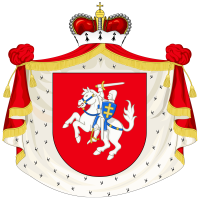Sanguszko: Difference between revisions
No edit summary |
No edit summary |
||
| Line 18: | Line 18: | ||
}} |
}} |
||
'''Sanguszko''' ({{lang-be|Сангушка}}, {{lang-ua|Сангушко}}) is a [[Poland|Polish]]-[[Lithuania]]n noble family of the [[Ruthenia]]n stock from the [[Gediminid dynasty]]. Like other [[prince]]ly houses of [[Polish-Lithuanian Commonwealth]], its origin are considered murky. Present historical opinion holds in favour of their descent from [[Algirdas]]' grandson '''Alexander Feodorovich''' (''fl.'' 1433-1443), lord of [[Kovel]] and [[Liuboml]], whose name can be shortened to ''Sangush''. The family supposedly descends from two lines, associated with two of his sons, ''Alexander'' and ''Michael''. |
'''Sanguszko''' ({{lang-be|Сангушка}}, {{lang-ua|Сангушко}}) is a [[Poland|Polish]]-[[Lithuania]]n noble family of the [[Ruthenia]]n (now [[Ukrainian]] stock from the [[Gediminid dynasty]]. Like other [[prince]]ly houses of [[Polish-Lithuanian Commonwealth]], its origin are considered murky. Present historical opinion holds in favour of their descent from [[Algirdas]]' grandson '''Alexander Feodorovich''' (''fl.'' 1433-1443), lord of [[Kovel]] and [[Liuboml]], whose name can be shortened to ''Sangush''. The family supposedly descends from two lines, associated with two of his sons, ''Alexander'' and ''Michael''. |
||
The senior line, called the ''Sanguszko-Koszyrski'', has been extinct since the death of [[Adam Aleksander Sanguszko]] in 1653. The junior line, or the ''Sanguszko-Kowelski'', of [[Szymon Samuel Sanguszko]], subsequently assumed the title ''Sanguszko-Lubartowicz'', according to the erroneous assumption of their descent from Algirdas' younger brother [[Lubart]]. |
The senior line, called the ''Sanguszko-Koszyrski'', has been extinct since the death of [[Adam Aleksander Sanguszko]] in 1653. The junior line, or the ''Sanguszko-Kowelski'', of [[Szymon Samuel Sanguszko]], subsequently assumed the title ''Sanguszko-Lubartowicz'', according to the erroneous assumption of their descent from Algirdas' younger brother [[Lubart]]. |
||
Revision as of 22:34, 23 June 2011
| Sanguszko | |
|---|---|
 | |
| Current region | Ukraine |
| Place of origin | Kovel |
| Members | Aleksander Zasławski Władysław Zasławski |
| Connected families | Ostrogski, Zasławski |
Sanguszko (Belarusian: Сангушка, Template:Lang-ua) is a Polish-Lithuanian noble family of the Ruthenian (now Ukrainian stock from the Gediminid dynasty. Like other princely houses of Polish-Lithuanian Commonwealth, its origin are considered murky. Present historical opinion holds in favour of their descent from Algirdas' grandson Alexander Feodorovich (fl. 1433-1443), lord of Kovel and Liuboml, whose name can be shortened to Sangush. The family supposedly descends from two lines, associated with two of his sons, Alexander and Michael.
The senior line, called the Sanguszko-Koszyrski, has been extinct since the death of Adam Aleksander Sanguszko in 1653. The junior line, or the Sanguszko-Kowelski, of Szymon Samuel Sanguszko, subsequently assumed the title Sanguszko-Lubartowicz, according to the erroneous assumption of their descent from Algirdas' younger brother Lubart.
Prince Paweł Karol Sanguszko-Lubartowicz (1682–1752), a Court and Grand Marshal of Lithuania, greatly expanded his holdings through his second marriage with Marianna Lubomirska, heiress of Ostroh. His chief residence at Slavuta (now in Ukraine) was embellished with a famous collection of Persian carpets, known as Sanguszko carpets. Hieronymous Sanguszko (1743–1812) founded the Slavuta stud, establishing the family as breeders of Arabian horses.
After partitions of Poland, Eustachy Erazm Sanguszko fought in the Kościuszko Uprising and Napoleon's Russian campaign. His son, Prince Roman Sanguszko, was a Polish officer who participated in the November Uprising, and was exiled to Siberia. His life is the subject of "Prince Roman" (1910) one of Joseph Conrad's short stories. With the incorporation of Galicia into Ukraine, the Sanguszkos lost their Gumniska and Slavuta estates, as well as a palace in Lviv, and emigrated to Brazil.
By the later 20th century, the family was represented by a single person, Prince Paul (born 1973), who resides in São Paulo. His mother came of the Polignac lineage.
